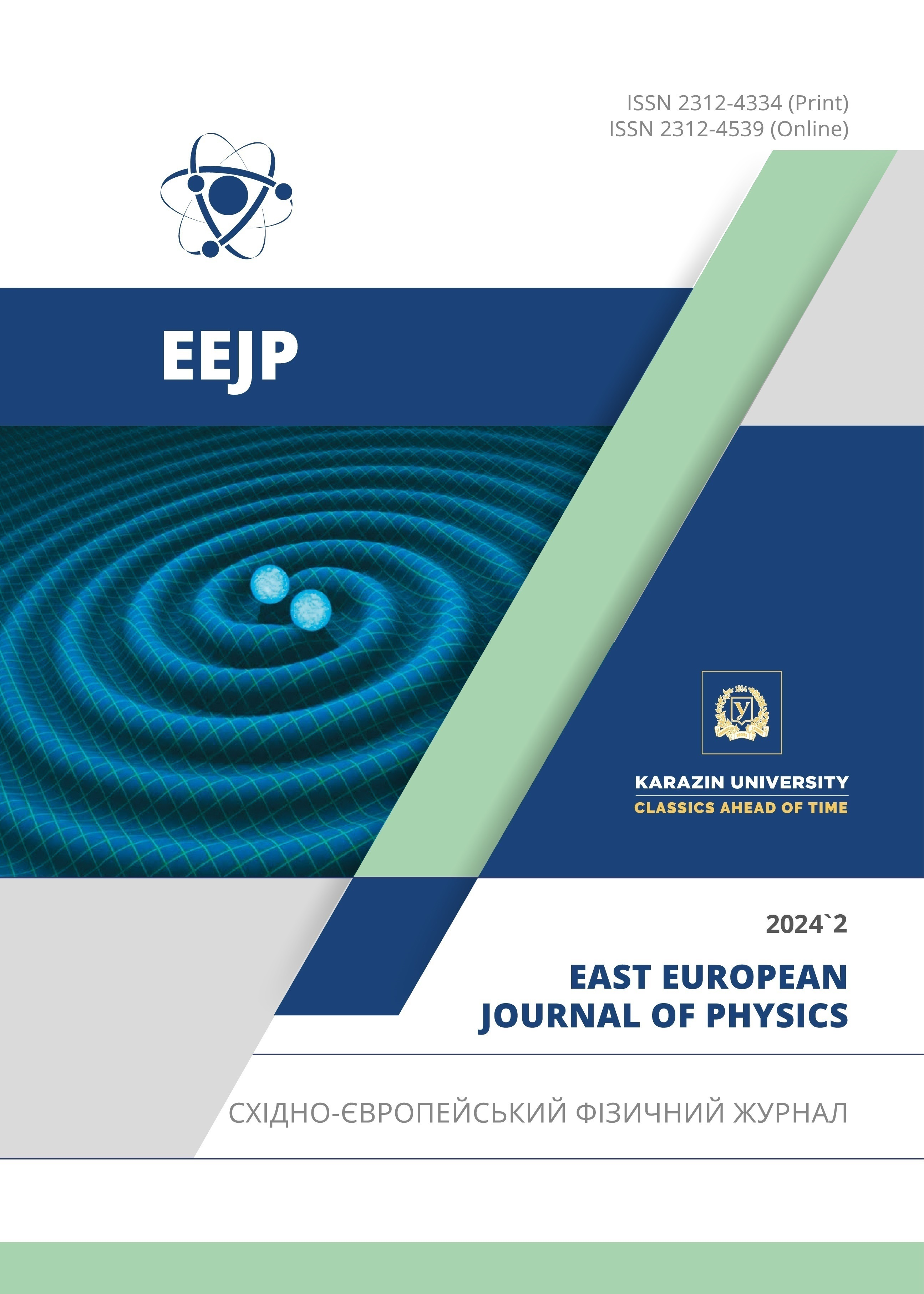X-Ray Structural and Photoelectric Properties of SnO2, ZnO, and Zn2SnO4 Metal Oxide Films
Abstract
The conditions and parameters for the synthesis of metal oxide films (ZnO, SnO2, and Zn2SnO4) by spray pyrolysis have been determined. The films were synthesized from aqueous solutions; the main differences between the methods were in the composition of the precursors, in the modes and time of deposition. The crystal structure of the Zn2SnO4 film corresponds to the cubic lattice, which belongs to the space group Fd3m with blocks 53 nm in size and lattice parameters a = 6.238 Å. Films of SnO2 and ZnO nanocrystallites 28 and 31 nm in size coherently arranged with lattices in the volume of thin Zn2SnO4 films can exhibit quantum size effects, which is of interest for modern nanotechnology. The crystals of the obtained SnO2 films have a tetragonal Bravais lattice with the space group P4 2/mnm with lattice parameters a = b = 4.836 Å and c = 3.245 Å, and the size of the SnO2 film subcrystals is 61 nm. The resulting ZnO films belong to the C6/mmc space group and the crystal lattice has a hexagonal syngony with the wurtzite structure with parameters a = b = 0.3265 nm and c = 0.5212 nm. It has been determined that, on the surface of the thin film grown, zinc oxide bumps with sizes LZnO ≈ 84 nm appear, which affect the unique properties of the samples. It is shown that the resulting thin Zn2SnO4, SnO2, and ZnO films can be used in a wide range of applications from sensitive sensor elements to coatings in transparent electronics in terms of their optical parameters.
Downloads
References
A. Pérez-Tomás, A. Mingorance, D. Tanenbaum, and M. Lira-Cantu, “Metal oxides in photovoltaics: all-oxide, ferroic, and perovskite solar cells,” The Future of Semiconductor Oxides in Next-Generation Solar Cells, 8(1), 267-356 (2018). https://doi.org/10.1016/B978-0-12-811165-9.00008-9
S.Z. Zainabidinov, S.I. Rembeza, E.S. Rembeza, and Sh.Kh. Yulchiev, “Prospects for the Use of Metal-Oxide Semiconductors in Energy Converters,” Applied Solar Energy, 55(1), 5–7 (2019). https://doi.org/10.3103/S0003701X19010146
H. Hosono, “Ionic amorphous oxide semiconductors: Material design, carrier transport, and device application,” Journal of Non-Crystalline Solids, 352(1), 851-858 (2006). https://doi.org/10.1016/j.jnoncrysol.2006.01.073
M Batzill, and U. Diebold, “The surface and materials science of tin oxide,” Progress in Surface Science, 79, 47–154 (2005). https://doi.org/10.1016/j.progsurf.2005.09.002
O. Ishchenko, V. Roge, G. Lamblin, D. Lenoble, and I. Fechete, “TiO2, ZnO, and SnO2-based metal oxides for photocatalytic applications: principles and development,” Comptes Rendus Chimie, 24,103-124 (2021). https://doi.org/10.5802/crchim.64
B. Stjerna, and C. Granqvist, “Optical and electrical properties of SnOx thin films made by reactive R.F. magnetron sputtering,” Thin Solid Films, 193, 704-711 (1990). https://doi.org/10.1016/0040-6090(90)90222-Y
X. Wen, Q. Zhang, and Z. Shao, “Magnetron Sputtering for ZnO: Scintillation film production and its application research status in nuclear detection,” Crystals, 9(5), 263 (2019). https://doi.org/10.3390/cryst9050263
R. Kumar, M. Sekhar, Raghvendra, R. Laha, and S. Pandey, “Comparative studies of ZnO thin films grown by electron beam evaporation, pulsed laser and RF sputtering technique for optoelectronics applications,” Applied Physics, 126, 859 (2020). https://doi.org/10.1007/s00339-020-04046-8
M. Chitra, “ZnO/SnO2/Zn2SnO4 nanocomposite: preparation and characterization for gas sensing applications,” Nanosystems: physics, chemistry, mathematics, 7(4), 707-710 (2016). http://dx.doi.org/10.17586/2220-8054-2016-7-4-707-710
S.Z. Zainabidinov, A.Y. Boboev, Kh.A. Makhmudov, and V.A. Abduazimov, “Photoelectric Properties of n-ZnO/p-Si Heterostructures. X,” Applied Solar Energy, 57(6), 475-479 (2021). https://doi.org/10.3103/S0003701X21060177
S. Zainabidinov, Sh. Utamuradova, and A. Boboev, “Structural Peculiarities of the (ZnSe)1-x-y(Ge2)x(GaAs1–δBiδ)y Solid Solution with Various Nanoinclusions,” Journal of Surface Investigation X-ray Synchrotron and Neutron Techniques, 16(6), 1130-1134 (2022). https://doi.org/10.1134/S1027451022060593
S. Zaynabidinov, Sh. Yuldashev, A. Boboev, and N. Yunusaliyev, “X-ray diffraction and electron microscopic studies of the ZnO(S) metal oxide films obtained by the ultrasonic spray pyrolysis method,” Herald of the Bauman Moscow State Technical University, Series Natural Sciences, 1(112), 78-92 (2024). https://doi.org/10.18698/1812-3368-2024-1-78-92
D. Elmurotova, N. Nishonova, F. Kuluyeva, and T. Muxtarova, Photoconductivity of gamma-irradiated Znse (Te)/ZnO:O and ZnSe(Te)/ZnO:O,Zn nanogeterojuctions. E3S Web of Conferences 383, 04051 (2023). https://doi.org/10.1051/e3sconf/202338304051
Sh. Shahzad, S. Javed, and M. Usman, “A Review on Synthesis and Optoelectronic Applications of Nanostructured ZnO” Front. Mater, 8, 613825 (2021) | https://doi.org/10.3389/fmats.2021.613825
Sh. Matussin, A. Rahman, and M. Khan, “REVIEW article: Role of Anions in the Synthesis and Crystal Growth of Selected Semiconductors,” Front. Chem. 10, 881518 (2022). https://doi.org/10.3389/fchem.2022.8815
N. Kamarulzaman, M.F. Kasim, and R. Rusdi, “Band Gap Narrowing and Widening of ZnO Nanostructures and Doped Materials,” Nanoscale Res. Lett. 10, 346 (2015). https://doi.org/10.1186/s11671-015-1034-9
O. Mounkachi, E. Salmani, M. Lakhal, H. Ez-Zahraouy, M. Hamedoun, M. Benaissa, A. Kara, et al., “Band-gap engineering of SnO2,” Solar Energy Materials and Solar Cells, 148, 34-38 (2016). https://doi.org/10.1016/j.solmat.2015.09.062
T. Mabate, N. Maqunga, S. Ntshibongo, M. Maumela, and N. Bingwa, “Metal oxides and their roles in heterogeneous catalysis: special emphasis on synthesis protocols, intrinsic properties, and their infuence in transfer hydrogenation reactions,” SN Applied Sciences, 5(196), 1-25 (2023). https://doi.org/10.1007/s42452-023-05416-6
Copyright (c) 2024 Khotamjon J. Mansurov, Akramjon Y. Boboev, Jakhongir A. Urinboyev

This work is licensed under a Creative Commons Attribution 4.0 International License.
Authors who publish with this journal agree to the following terms:
- Authors retain copyright and grant the journal right of first publication with the work simultaneously licensed under a Creative Commons Attribution License that allows others to share the work with an acknowledgment of the work's authorship and initial publication in this journal.
- Authors are able to enter into separate, additional contractual arrangements for the non-exclusive distribution of the journal's published version of the work (e.g., post it to an institutional repository or publish it in a book), with an acknowledgment of its initial publication in this journal.
- Authors are permitted and encouraged to post their work online (e.g., in institutional repositories or on their website) prior to and during the submission process, as it can lead to productive exchanges, as well as earlier and greater citation of published work (See The Effect of Open Access).








